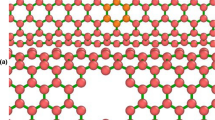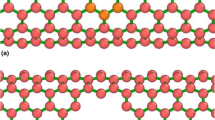Abstract
Single walled carbon nanotubes (SWCNTs) are ideal choices for resonators due to its ultrahigh natural frequency. Fundamental frequency of resonators significantly affects their functionality and performance; therefore, an accurate prediction of SWCNTs’ natural frequency is vital for designing and developing such devices. In reality, CNTs are not straight and perfect; indeed, they have some degree of vacancy defect and waviness, which occurs during growth and manipulation processes. This research investigates for the first time the combination effects of both initial curvature and vacancy defects on vibrational behaviour of SWCNTs in order to make the simulation closer to the “real world”. In this study, an efficient method based on the molecular dynamics model and the finite element method is used to simulate wavy SWCNTs with vacancy defects. Zigzag carbon nanotube with chirality indices (5, 0) is considered. Accuracy of our modelling method is verified by comparing our results with the results obtained from previous studies in simulating ideal SWCNT natural frequency. The effects of vacancy, vacancy location, curvature and aspect ratio on natural vibration of the defected wavy SWCNTs have been investigated, and a parameter of critical waviness ratio has been defined for the first time to emphasize the combination effect of vacancies and waviness on the natural frequency of SWCNTs. Our results show that critical waviness is sensitive to the aspect ratio and indicate that by increasing the length of SWCNTs, the critical waviness ratio increases.







Similar content being viewed by others
References
Bell JM, Goh RGS, Waclawik ER, Giulianini M, Motta N (2008) Polymer-carbon nanotube composites: basic science and applications. Mater Forum 32:144–152
Bodily BH, Sun CT (2003) Structural and equivalent continuum properties of single-walled carbon nanotubes. Int J Mater Prod Technol 18(4):381–397
Cornell WD, Cieplak P, Bayly CI, Gould IR, Merz KM, Ferguson DM, Kollman PA (1995) A second generation force field for the simulation of proteins, nucleic acids, and organic molecules. J Am Chem Soc 117(19):5179–5197
Dao DV, Bui TT, Nakamura K, Dau VT, Yamada T, Hata K, Sugiyama S (2010) Towards highly sensitive strain sensing based on nanostructured materials. Adv Nat Sci Nanosci Nanotechnol 1(4):045012
Dau VT, Yamada T, Dao DV, Tung BT, Hata K, Sugiyama S (2010a) Integrated CNTs thin film for MEMS mechanical sensors. Microelectron J 41(12):860–864
Dau VT, Dao DV, Yamada T, Tung BT, Hata K, Sugiyama S (2010b) Integration of SWNT film into MEMS for a micro-thermoelectric device. Smart Mater Struct 19(7):075003
De Los Santos HJ (1999) Introduction to micorelectromechanical (MEM) microwave systems(Book). Artech House, Norwood, p 1999
Farsadi M, Öchsner A, Rahmandoust M. (2012) Numerical investigation of composite materials reinforced with waved carbon nanotubes. J Compos Mater: 0021998312448495
Georgantzinos SK, Giannopoulos GI, Anifantis NK (2009) An efficient numerical model for vibration analysis of single-walled carbon nanotubes. Comput Mech 43(6):731–741
Ghavamian A, Öchsner A (2013) Numerical modeling of eigenmodes and eigenfrequencies of single-and multi-walled carbon nanotubes under the influence of atomic defects. Comput Mater Sci 72:42–48
Gibson RF, Ayorinde EO, Wen YF (2007) Vibrations of carbon nanotubes and their composites: a review. Compos Sci Technol 67(1):1–28
Goh RG, Bell JM, Motta N, Ho PKH, Waclawik ER (2009) < i > p </i > -Channel, < i > n </i > -Channel and ambipolar field-effect transistors based on functionalized carbon nanotube networks. Superlattices Microstruct 1:347–356
Iijima S (1991) Helical microtubules of graphitic carbon. Nature 354(6348):56–58
Imani Yengejeh S, Delgado JM, de Lima AGB, Öchsner A. (2014). Numerical Simulation of the Vibration Behavior of Curved Carbon Nanotubes. Adv Mater Sci Eng. doi:10.1155/2014/815340
Jensen K, Weldon J, Garcia H, Zettl A (2007) Nanotube radio. Nano Lett 7(11):3508–3511
Jensen K, Kim K, Zettl A (2008) An atomic-resolution nanomechanical mass sensor. Nat Nanotechnol 3(9):533–537
Jorgensen WL, Severance DL (1990) Aromatic-aromatic interactions: free energy profiles for the benzene dimer in water, chloroform, and liquid benzene. J Am Chem Soc 112(12):4768–4774
Karami Mohammadi A, Amjadipoor M (2011) Effect of vacancy defect on natural vibration of single walled carbon nanotube as ultrahigh nanoresonators. J Vibroeng JVE 3:414–422
Li C, Chou TW (2003a) Single-walled carbon nanotubes as ultrahigh frequency nanomechanical resonators. Phys Rev B 68(7):073405
Li C, Chou TW (2003b) A structural mechanics approach for the analysis of carbon nanotubes. Int J Solids Struct 40(10):2487–2499
Motta N (2012) Nanostructures for sensors, electronics, energy and environment. Beilstein J Nanotechnol 3(1):351–352
Nasdala L, Ernst G (2005) Development of a 4-node finite element for the computation of nano-structured materials. Comput Mater Sci 33(4):443–458
Odegard GM, Gates TS, Nicholson LM, Wise KE (2002) Equivalent-continuum modeling of nano-structured materials. Compos Sci Technol 62(14):1869–1880
Ouakad HM, Younis MI (2011) Natural frequencies and mode shapes of initially curved carbon nanotube resonators under electric excitation. J Sound Vib 330(13):3182–3195
Poncharal P, Wang ZL, Ugarte D, De Heer WA (1999) Electrostatic deflections and electromechanical resonances of carbon nanotubes. Science 283(5407):1513–1516
Qian D, Dickey EC, Andrews R, Rantell T (2000) Load transfer and deformation mechanisms in carbon nanotube-polystyrene composites. Appl Phys Lett 76(20):2868–2870
Rappé AK, Casewit CJ, Colwell KS, Goddard Iii WA, Skiff WM (1992) UFF, a full periodic table force field for molecular mechanics and molecular dynamics simulations. J Am Chem Soc 114(25):10024–10035
Sazonova VA (2006) A tunable Carbon Nanotube Resonator. Ph.D. Thesis, Department of Physics, Cornell University
Shiraishi N, Ikehara T, Dao DV, Sugiyama S, Ando Y (2013) Fabrication and testing of polymer cantilevers for VOC sensors. Sens Actuat A 202:233–239
Suenaga K, Wakabayashi H, Koshino M, Sato Y, Urita K, Iijima S (2007) Imaging active topological defects in carbon nanotubes. Nat Nanotechnol 2(6):358–360
Zhu Y, Dao DV, Woodfield P (2014) A fluid density sensor based on a resonant tube. Adv Natural Sci Nanosci Nanotechnol 5(3):035010
Author information
Authors and Affiliations
Corresponding author
Rights and permissions
About this article
Cite this article
Amjadipour, M., Dao, D.V. & Motta, N. Vibration analysis of initially curved single walled carbon nanotube with vacancy defect for ultrahigh frequency nanoresonators. Microsyst Technol 22, 1115–1120 (2016). https://doi.org/10.1007/s00542-015-2470-2
Received:
Accepted:
Published:
Issue Date:
DOI: https://doi.org/10.1007/s00542-015-2470-2




